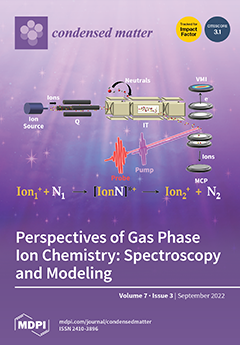The effects of K
+ substitution at the Ba-site on the structural, magnetic, and electrical properties and magnetoresistance (MR) of La
0.7Ba
0.3−xK
xMnO
3 (
x = 0 and 0.04) manganites prepared via the solid-state method were
[...] Read more.
The effects of K
+ substitution at the Ba-site on the structural, magnetic, and electrical properties and magnetoresistance (MR) of La
0.7Ba
0.3−xK
xMnO
3 (
x = 0 and 0.04) manganites prepared via the solid-state method were investigated. Rietveld refinement of X-ray diffraction data confirmed that both samples were crystallized in the rhombohedral structure with the
R3 space group. In addition, the unit cell volume,
V, and the average grain size also increased with K
+ ions. Magnetization versus applied field (
M–
H) measurement was carried out, and the saturation magnetization (
Ms) was found to increase from 1.81
/f.u. (
x = 0) to 4.11
/f.u. (
x = 0.04), implying that K
+ ions strengthened the ferromagnetic (FM) interaction. Furthermore, the metal–insulator transition temperature,
TMI, increased from 257 K (
x = 0) to 271 K (
x = 0.04). The observed behaviour may be related to the enhancement of double-exchange (DE) interaction due to the increase in Mn-O-Mn bond angle and electronic bandwidth (
W), favouring the increasing rate of the e
g electron hopping process. The fitting of the electrical resistivity data in the metallic region describes the significance of residual resistivity, electron–electron and electron–magnon scattering processes to elucidate the electronic transport properties. Within the insulating region, variable range hopping (VRH) and small polaron hopping (SPH) models are proposed to describe the conduction mechanism.
Full article





